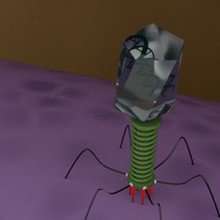Phage-host interactions are more complicated than most laboratory studies suggest

For years, scientists have experimented with phages—the viruses that infect bacteria—to learn how they change their host. Because such studies are difficult to accomplish in the wild, most have focused on viruses and host cells tailored for laboratory experiments. Now a team of scientists departs from these "optimal" laboratory-suitable viruses to study the molecular response when bacteria and phages interact in nature, where phages do not always encounter the perfect host.
Phage research has helped identify DNA as the hereditary material and described the nature of gene expression in microbes, but studies of interactions are largely limited to laboratory studies featuring optimal infection conditions. Broadening the understanding of how efficiently phages infect a host in nature can help scientists develop better ecosystem models, devise more sustainable biotechnology, and improve human health.
Building on previous research, scientists from The Ohio State University, Pacific Northwest National Laboratory, and EMSL, the Environmental Molecular Sciences Laboratory, studied vast amounts of data on proteins and the messenger RNA molecules associated with them to look at how efficiently two different phages infected similar bacteria. The bacterial strains are common in the environment, and their close relatives are found in soils, water, and humans. They affect nutrient turnover, health, and disease. By taking regular measurements as the infection progressed using the Orbitrap mass spectrometer and next generation sequencers at EMSL, a DOE Office of Science user facility, the team was able to capture all the internal viral and bacterial changes. For the first time, the work identified multiple infection inefficiencies in such interactions—from poorer adsorption at the cell surface to intercellular responses by the host that repressed the phage's ability to take over the host, express its genes, or make its proteins. These inefficiencies suggest phage-host interactions in nature are more complicated than traditional laboratory studies have shown. Results will help scientists better understand, predict, and enhance the functioning of microbial communities important to industry, agriculture, and human health.
More information: Multiple mechanisms drive phage infection efficiency in nearly-identical hosts. ISEM J. (2018). DOI:org/10.1038/s41396-018-0099-8
Provided by Environmental Molecular Sciences Laboratory

















